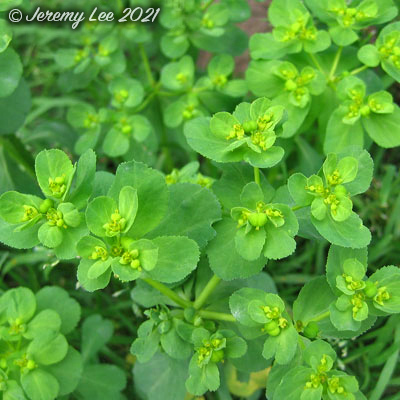
 |
|
Scientific Classifications explained » Amphibians » Ants » Aphids » Bees » Beetles » Birds » Bugs » Butterflies » Caterpillars » Damselflies » Dragonflies » Earwigs » Flies » Frog/Leafhoppers » Fungi » Galls » Grasshoppers » Harvestmen » Hoverflies » Lacewings » Ladybirds » Leaf Mines » Lichens » Mammals » Millipedes » Mosses » Moths » Sawflies » Slugs » Snails » Spiders » Trees » Wasps » Wild Flowers » Woodlice |
UK Nature > Wild Flowers > Green Wild Flowers > Euphorbia helioscopia

Scientific Name: Euphorbia helioscopia Common Name: Sun Spurge Euphorbia helioscopia, more commonly known as Sun Spurge, is an annual plant of cultivated fields and waste places on sandy and clay loams. It grows 10–50cm in height, with a single, erect, hairless stem, branching toward the top. The leaves are oval, broadest near the tip, 1.5–3cm long, with a finely toothed margin. The flowers are small, yellow-green, with two to five basal bracts similar to the leaves but yellower; flowering lasts from mid spring to late summer. Sun spurge bleeds a milky sap when cut that can be a skin irritant. The seeds contain an oil that is a violent purgative in man and animals. Active ingredients are extracted from it for use in the pharmaceutical industry. It is also used in Chinese traditional medicine. Sun spurge is common throughout the UK especially in lowland areas, flowering from May to October. |
|

https://www.uknature.co.uk is a website dedicated to showing the immense diversity of UK nature and wildlife. Our vast range of habitats, from lowland arable to snow covered mountains, from storm-ravaged coastlines to peaceful inland freshwater lakes and rivers, from dry, sandy heaths to deciduous and coniferous forests, all these habitats contribute to the abundance of UK nature. We have wild birds in huge numbers either residing or visiting our shores (597 recorded species as at July 2013) and we must also not forget the humble back garden with its grass lawns, flower beds filled with nectar rich flowers, shrubs and trees, all designed to attract huge numbers of insects such as bees, moths, butterflies and hoverflies; and finally the small ponds which provide safe havens for frogs, toads, newts and even slow worms and grass snakes. www.uknature.co.uk is the showcase for my personal passion, photographing uknature in all its glory. I sincerely hope you all enjoy the fruits of my labours. This site and all images contained therein is © Jeremy Lee 2004 - 2025. All Rights Reserved. Site design by Jeremy Lee. Site development & IT Support by Stuart Lee. |